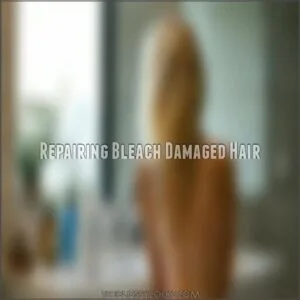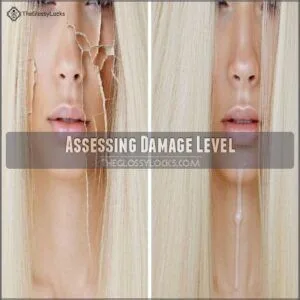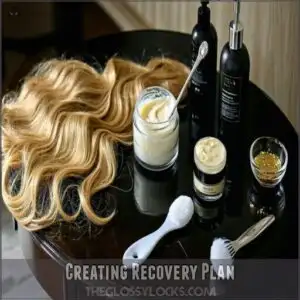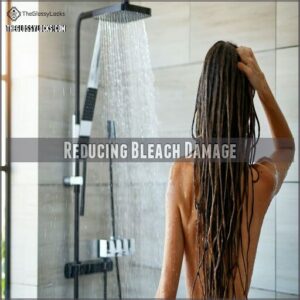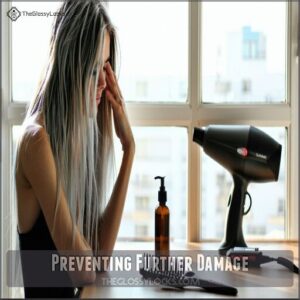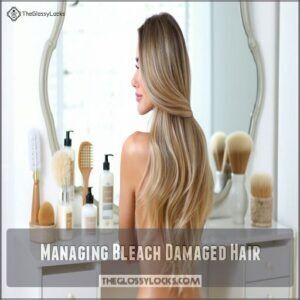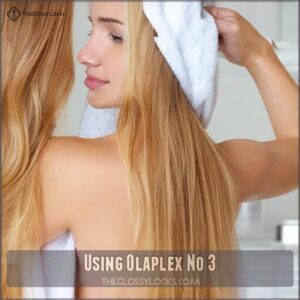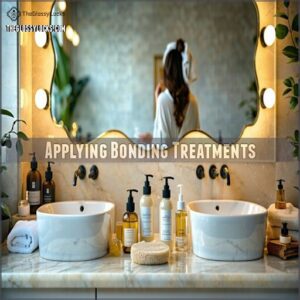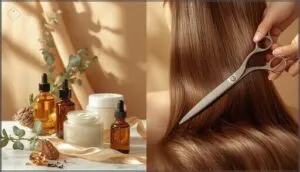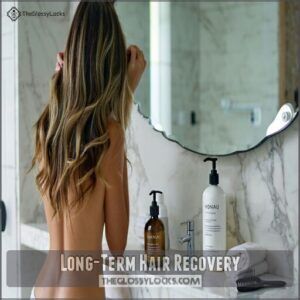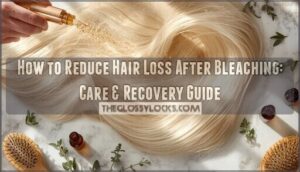This site is supported by our readers. We may earn a commission, at no cost to you, if you purchase through links.
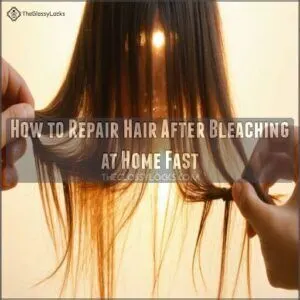 You’ve bleached your hair at home and now it’s crying out for help.
You’ve bleached your hair at home and now it’s crying out for help.
Don’t worry, you can repair it, and gentle care is key to this process. Start by taking immediate action – repair techniques are crucial.
Minimize heat styling, use a wide-toothed comb, and lock in moisture with a hair shield.
When you learn how to repair hair after bleaching at home, you’ll be on your way to restoring your locks to their former glory, and we’ve got some valuable tips to share on making that happen.
Table Of Contents
- Key Takeaways
- Repairing Bleach Damaged Hair
- Repair Hair After Bleaching
- Reducing Bleach Damage
- Preventing Further Damage
- Managing Bleach Damaged Hair
- Repairing Broken Hair Bonds
- Maintaining Healthy Hair
- Long-Term Hair Recovery
- Frequently Asked Questions (FAQs)
- Can bleach damaged hair be repaired overnight?
- How to fix damaged hair caused by bleaching?
- How do you repair bleach damaged hair?
- How to restore hair after bleaching?
- Will bleach damaged hair grow back?
- Should I bleach my hair at home?
- How to fix damaged hair after bleaching?
- How long does it take for your hair to heal after bleaching?
- How to make hair soft and silky after bleaching?
- How do I get my bleached hair back to normal?
- Conclusion
Key Takeaways
- You’ll want to take immediate action to repair your hair after bleaching, minimizing heat styling, using a wide-toothed comb, and locking in moisture with a hair shield to prevent further damage.
- To assess the damage, you’ll check for dryness, dullness, and breakage, evaluating hair porosity and performing a split end evaluation to determine the best course of action for recovery.
- You can reduce bleach damage by lowering your shower temperature, using a shower filter to soften hard water, and finishing your shower with a cool blast to seal your hair cuticle and boost hydration.
- To maintain healthy hair after bleaching, you’ll focus on eating a balanced diet, using sulfate-free shampoos, and protecting your hair from chlorine, and consider using repairing hair masks, scheduling regular haircuts, and being patient with the recovery process.
Repairing Bleach Damaged Hair
You’re likely reading this because you’ve bleached your hair and it’s now damaged – don’t worry, it’s a common issue that can be fixed.
By taking the right steps, you can repair your bleach-damaged hair and get it back to its healthy, vibrant state, and we’ll guide you through the process.
Immediate Action Required
You need Emergency Care for bleached hair.
Consider:
- Hair Rescue
- Damage Control
- Quick Fix
- Crisis Management
Post bleach care to fix over-bleached hair with a bleach damage remedy, focusing on repair bleached ends with hair repair tips.
Avoiding Further Damage
After taking immediate action, you’ll want to focus on avoiding further damage.
Use gentle combing and a wide-toothed comb to prevent breakage, and consider a hair shield to lock in moisture.
Acting as a remedy to bleach damage and a method of hair protection and damage control.
Professional Help
You’re likely feeling overwhelmed after bleaching your hair.
Consider a Hair Consultation with a professional stylist for Damage Assessment and Repair Planning.
They offer salon services, including salon treatment and professional hair care.
- Get personalized advice
- Receive a customized repair plan
- Learn about salon services
- Understand professional hair treatment
- Benefit from stylist advice
Repair Hair After Bleaching
You’re taking the first step to repairing your hair after bleaching, and that’s great.
Now it’s time to assess the damage and create a recovery plan.
By following the right steps, you can help restore your hair’s health and shine, and get back to having the beautiful, vibrant locks you deserve.
Assessing Damage Level
Assess your bleach damaged hair by checking for dryness, dullness, and breakage.
Evaluate hair porosity, and perform a split end evaluation to determine fragility.
Using high-quality hair products is essential for maintaining hair health after bleaching.
| Damage Assessment | Hair Porosity | Breakage Analysis |
|---|---|---|
| High | Low | Severe |
| Medium | Medium | Moderate |
| Low | High | Mild |
| Extreme | Very Low | Very Severe |
| Normal | Normal | Normal |
The table provides a damage assessment guide, helping you to evaluate the condition of your hair and take necessary steps to improve its porosity and overall health.
Creating Recovery Plan
Now that you’ve assessed the damage, it’s time to create a recovery plan.
Develop a hair restoration strategy, focusing on nourishment and repair techniques to fix over-bleached hair.
Try hair moisturizing treatments and protein treatments to restore hair health, and explore other hair repair tips for desired results.
Understanding color correction techniques is essential to address unwanted tones and achieve the desired hair color.
Reducing Bleach Damage
You’re taking the first step to reduce bleach damage by learning how to care for your hair after bleaching.
By following simple tips, such as lowering your shower temperature and using a shower filter, you can help minimize further damage and get your hair on the road to recovery.
Lowering Shower Temperature
You can reduce bleach damage by lowering your shower temperature.
- Cool Water Benefits for hair hydration
- Gentle Rinsing to prevent Warm Water Damage
- Hair Porosity reduction for better hair nourishment
Using Shower Filter
You can install a shower filter to soften hard water, reducing bleach damage.
For additional tips, check out this guide on repairing bleach-damaged hair.
This water purification system helps minimize hair damage from harsh minerals, making it a great fix for over-bleached hair and a useful tool for hair repair after bleaching mistakes. Filter benefits include softer water.
Ending Shower With Cool Blast
Finish your shower with a cool blast to seal your hair cuticle, boosting hydration and reducing damage.
- Cool Water Benefits for hair hydration
- Cold Rinse for moisturizing
- Blast Therapy for hair nourishment
Preventing Further Damage
You’re taking the right steps to repair your bleached hair, and now it’s time to focus on preventing further damage.
By minimizing heat styling and protecting your hair from UV light, you can help reduce breakage and promote healthier-looking locks.
Minimizing Heat Styling
To prevent further damage, minimize heat styling by opting for heatless styling, cool rinses, or low heat with gentle tools.
Then try air drying to reduce breakage.
Use hair repair products like a hair strengthening mask and nourishing shampoo with a heat protectant.
Protecting From UV Light
You can protect your bleached hair from UV light by using:
- Sunscreen sprays
- Hair sunblock
- SPF products
These provide UV protection, preventing further hair damage and chlorine damage, and aid in hair damage prevention, ensuring your locks stay healthy and vibrant.
Managing Bleach Damaged Hair
You’re taking the first step toward repairing your bleach-damaged hair, and that’s great.
By managing your damaged locks with the right techniques, such as using leave-in conditioners and hair oils, you can help restore its health and shine.
Using Leave-in Conditioners
You can lock in moisture and control frizz with a leave-in conditioner, a great hair serum for bleached hair care, offering leave-in benefits and conditioner tips for hair nourishment and hydration methods, perfect for hair repair products and bleached hair care.
Consider exploring leave-in conditioner product options specifically designed for bleached hair.
Applying Hair Oils
You apply hair oils to nourish damaged hair.
Bleached hair requires specialized oils, so consider exploring hair oil product options.
- Argan Oil
- Coconut Oil
- Hair Serum
- Oil Treatment
- Leave-in conditioner for moisturizing benefits, using hair serums and oil treatments like Argan and Coconut oil, which provide nourishing benefits.
Avoiding Excessive Washing
When washing bleached hair, reduce frequency to retain moisture.
Use gentle, sulfate-free shampoo and dry shampooing to minimize stripping hair of its natural oils, promoting hair nourishment and hydration methods for ideal hair health.
Understanding the benefits of sulfate free products can further enhance hair care routines, focusing on hair care.
Repairing Broken Hair Bonds
You’re taking the first step to fix your bleached hair by learning how to repair broken hair bonds.
By using products like Olaplex No 3 and incorporating protein masks into your routine, you can start to restore your hair’s health and strength.
Using Olaplex No 3
You’ll frequently use Olaplex No 3, an at-home hair repairing treatment, to rebuild and restore broken bonds in bleach damaged hair, promoting hair repair, bond restoration, and damage reversal.
This treatment is part of a larger hair repair process that can help restore the health of damaged hair, making it an essential at-home treatment for hair strengthening and protein treatment after hair bleaching mistakes, which aids in damage reversal.
Applying Bonding Treatments
You’re taking control of your bleach damaged hair by exploring bond treatments.
Bond repair and hair rebuilding are key to restoring your locks.
Consider keratin therapy or protein treatment to repair bleached hair, focusing on damage restoration and hair bonding for strong, healthy hair.
Incorporating Protein Masks
You’re strengthening your locks with bonding treatments, now boost with protein masks.
Try DIY treatments or keratin-packed masks, 1-2 times a week, for a hair protein treatment that repairs and strengthens.
Giving you a hair strengthening mask for fabulous, healthy hair with protein benefits.
Maintaining Healthy Hair
You’re taking the right steps to repair your hair after bleaching by learning how to maintain its health.
By eating a balanced diet, using sulfate-free shampoos, and protecting your hair from chlorine, you’ll be well on your way to keeping your locks strong and vibrant.
This approach will help you achieve healthy hair.
Eating Balanced Diet
By fueling your body with balanced meals, you support hair nourishment.
Make certain a nutrient balance, including healthy fats, vitamins, and antioxidants for hair health and recovery, boosting your vitamin intake with dietary supplements if necessary, focusing on vitamin intake.
Using Sulfate-Free Shampoos
You’re eating a balanced diet, now switch to a sulfate-free shampoo for gentle cleansing, preserving hair moisture, and promoting scalp health with natural ingredients, perfect for bleach damaged hair.
- Use sulfate alternatives
- Choose gentle shampoo
- Prioritize hair nourishment
Protecting From Chlorine
When swimming, protect your bleached hair from chlorine damage with a swim cap or hair sunblock.
Rinse with cool water before and after pool exposure to minimize pool chlorine damage, aiding in hair damage repair and preventing further bleach damage.
Applying natural oils before swimming can create a protective barrier.
| Pool Protection | Chlorine Rinse | Hair Sunblock |
|---|---|---|
| Swim Cap | Cool Water | SPF Spray |
| Hair Oil | Chlorine Removal | Leave-in Conditioner |
| Bleach Damage | Hair Repair | Pool Protection |
The table outlines various methods for pool protection and hair repair, including the use of a swim cap, cool water rinse, and hair sunblock to prevent chlorine damage.
Long-Term Hair Recovery
You’re taking the first step toward long-term hair recovery, and it’s great that you’re prioritizing your hair’s health.
By being patient, using repairing hair masks, and scheduling regular haircuts, you’ll be on your way to restoring your hair’s natural shine and strength.
Being Patient With Recovery
You’re on the road to hair recovery. Here are patience tips:
- Wait for growth
- Avoid heat
- Use gentle products
- Stay hydrated
- Be kind to bleach damaged hair, allowing time for the healing process and damage control, embracing hair patience for effective hair nourishment and hydration.
Using Repairing Hair Masks
You can accelerate hair recovery by using a hair mask once or twice a week, leveraging natural ingredients like olive oil, coconut oil, and shea butter for deep conditioning and moisturizing.
This helps repair damaged hair bonds and lock in nourishment, which is crucial for maintaining healthy hair, and the use of natural ingredients can significantly enhance this process.
Scheduling Regular Haircuts
You’ll want to schedule regular haircuts to prevent split ends and breakage, promoting healthy hair growth.
Regular trims help maintain cuticle care, supporting the hair growth cycle.
Consider your hair’s texture and length when scheduling.
By doing so, you’ll reap the benefits of hair trim benefits, including split end prevention and improved hair maintenance.
Frequently Asked Questions (FAQs)
Can bleach damaged hair be repaired overnight?
You can’t repair bleach-damaged hair overnight, but with patience, the right products, and gentle care, you can start the recovery process.
You can get your hair back to its healthy, vibrant state.
How to fix damaged hair caused by bleaching?
You can fix damaged hair by using nourishing products, reducing heat styling, and getting regular trims to prevent split ends and breakage, promoting healthy hair growth and strength over time.
How do you repair bleach damaged hair?
You can restore your hair’s health by using nourishing products, reducing heat styling, and getting regular trims to prevent split ends and breakage, promoting stronger, shinier locks over time.
How to restore hair after bleaching?
You can restore your hair after bleaching by using nourishing products, minimizing heat styling, and getting regular trims to prevent split ends and breakage, promoting healthy hair growth.
Will bleach damaged hair grow back?
Like a phoenix, your damaged locks will rise again – with time, patience, and proper care, bleach-damaged hair can grow back strong and healthy, don’t worry, it’s a slow process.
Should I bleach my hair at home?
You shouldn’t bleach your hair at home, as it can lead to damage, dryness, and breakage, so consider consulting a professional stylist for safer, more controlled results and guidance.
How to fix damaged hair after bleaching?
You can rescue damaged locks by using nourishing masks, gentle shampoos, and hydrating oils to replenish moisture and strengthen hair strands after a bleaching disaster.
How long does it take for your hair to heal after bleaching?
You’ll wait several months to a year for your hair to fully heal after bleaching, so be patient and focus on nourishing and protecting it during the recovery process.
How to make hair soft and silky after bleaching?
You’ve torched your locks, now try nourishing masks, argan oil, and gentle conditioners to revive softness and silkiness, giving your hair a second chance at fabulousness.
How do I get my bleached hair back to normal?
You can restore your bleached hair by using nourishing products, reducing heat styling, and getting regular trims to prevent split ends and breakage, promoting healthy hair growth over time slowly.
Conclusion
Ironically, bleaching your hair can be a real headache, but learning how to repair hair after bleaching at home can be a lifesaver.
You’re now equipped to tackle the damage, so go ahead and show your locks some love.
By following these tips on how to repair hair after bleaching at home, you’ll be on your way to healthier, happier hair in no time.
- https://us.davines.com/blogs/news/how-to-rehydrate-your-hair-after-bleaching
- https://www.healthline.com/health/beauty-skin-care/how-to-hydrate-hair-after-bleaching
- https://hairlust.com/blogs/blog/repair-bleach-damaged-hair
- https://pumphaircare.com/blogs/tashs-blog/fix-bleached-damaged-hair
- https://www.reddit.com/r/HaircareScience/comments/a0air9/how_to_restore_bleached_hair/

